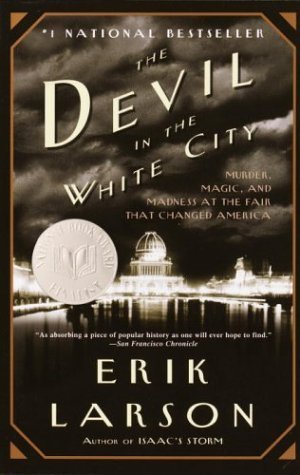
The Devil in the White City, written by Eric Larson
presents us with historical fiction at its best. The White City is the Chicago Worlds Fair in 1892, and the Devil is H. H. Holmes, aka Herman Webster Mudgett, an extraordinarily successful lady killer (both figuratively and literally). The book alternates between two concurrent stories about two men, the driven architect, Daniel Burnham who is building the World's Fair, and the serial killer, Holmes, building the World's Fair death hotel.
This story brings you into the raw driving capitalism that started the sculpting of the Chicago skyline along with the new building technology that made this happen. The determination to surpass the wow factor of the 1889 World's Fair held in Paris resulted in the first observation wheel, later known as the Ferris wheel named after George Washington Gale Ferris Jr. This story, alone, was fascinating as we learn that only after a number of rejections was Ferris successful in convincing Burnham that his design wouldn't be a source of 2000 deaths in a single turn, but a sure way to best Paris where Gustave Eiffel had built the tallest man made structure in the world . The spirit and drive of the architects, the side stories of the historical figures that made this possible, the incredible planning where ones dreams could come true, the fires, storms, accidents and bureaucracy that threatened the success of the fair made this a fantastic and highly entertaining tale.
The chapters alternate between the exciting building of the fair to the more disturbing tale of the psychopath extraordinaire, H. H. Holmes, a disgusting killer who charmed women, married them, and then murdered them when the timing would be most advantageous to his personal finances. There was no discretion in whom his victims were, be they children, friends, or strangers.
I was so appalled that people could be taken in by such a person that I bought and read The Sociopath Next Door by Dr. Martha Stout . Dr. Stout is spot on in her description of this personality. For you who want to see more of this despicable personality, just watch the new Fargo television show!
I was so appalled that people could be taken in by such a person that I bought and read The Sociopath Next Door by Dr. Martha Stout . Dr. Stout is spot on in her description of this personality. For you who want to see more of this despicable personality, just watch the new Fargo television show!
Aside from the review of Devil in the White City, I would like to tell you a bit that I have learned of this nature. People exist that don't care about other people; they have no empathy as they selfishly destroy anything that gets in the way of their agenda. They can't be cured. Correctly labeled as "antisocial personality disorder", they consistent of 4% of our population and 20% of our prison population. The problem is that people with this disorder, though not necessary killers as H.H. Holmes, are only detectable to the rest of the 96% by viewing their actions. You can't tell what people are thinking! Really rotten bad people who want to destroy you can be very nice.
The topics covered within the rich Chicago setting in the Gilded age, a time of rapid growth wrapped in social conflict, are reminiscent to me of a Chopin ballad; there is enough material here to write a damn rich series of books centered on the events that were just touched, but it is all stuffed into one. It will make you crave more.
I am interested in seeing how this story unfolds in film as the movie is in development staring Leonardo DiCaprio as the despicable Holmes. Now, I wonder which of the stories Hollywood will emphasize, the fair or the death hotel, or perhaps they will be given equal billing?

 "The Book Thief" by Markus Zusak is an absolute work of art. Even though the story has been made into a movie, film would never be able to capture the author's style of imaginative narration chosen to weave his tale.
"The Book Thief" by Markus Zusak is an absolute work of art. Even though the story has been made into a movie, film would never be able to capture the author's style of imaginative narration chosen to weave his tale.